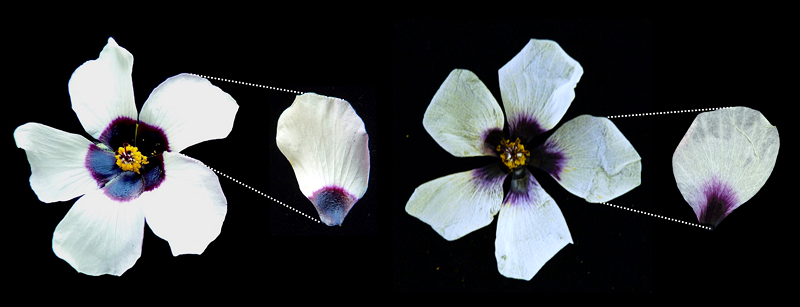Research Interests
Plants tune their growth and development to enable their survival and active interaction with the environment despite being sessile. I am interested in understanding the molecular mechanisms underpinning developmental and cell fate decisions which ensure proper patterning, growth and development of plants. In my research, I have used a combination of genetics, molecular biology, microscopy and mathematical modelling to understand the mechanisms of plant development and morphogenesis.
Boundary formation in petal patterning
Flowering plants display a variety of petal patterns that are key for attracting pollinators. Hibiscus trionum flowers have a bullseye pattern, with distinct pigmentation, cell shape and cuticular structure in the proximal and distal region of the petal. Creation of the bullseye pattern requires the formation of a clear boundary separating the two regions as the petal develops, but the mechanisms involved are unknown. In my PhD under the supervision of Edwige Moyroud at SLCU, I am currently investigating the mechanisms that create the boundary between the two distinct regions of the Hibiscus petal. Using a combination of genetics, microscopy and mechanical perturbations, I am characterising boundary establishment with spatiotemporal resolution and examining the role of key genes involved in boundary formation.
Left: Wild-type Hibiscus trionum with a clearly defined boundary separating the dark proximal region and the white distal region. Right: Transgenic 35S::HtCRUMBLE with perturbed boundary formation in which the boundary appears diffuse.
Variability in germination time
In unpredictable environments, variability in seed germination time can be beneficial for survival. In my undergraduate research project under the supervision of Ottoline Leyser and James Locke at SLCU, I investigated the molecular mechanisms underlying variability in Arabidopsis seed germination time. Using a mathematical model that captures the decision to germinate by an abscisic acid (ABA)-gibberellic acid (GA) bistable switch, I explored the effect of hormonal sensitivity on variability in germination time.
Career
I studied Natural Sciences at the University of Cambridge from 2015 to 2019, specialising in Plant Sciences for my Bachelor of Arts (BA) and Systems Biology for my Master of Natural Sciences (MSci). I am currently doing a PhD in Plant Sciences at SLCU and am affiliated to the Department of Plant Sciences, University of Cambridge.
Publications
K Abley, P Formosa-Jordan, H Tavares, EYT Chan, M Afsharinafar, O Leyser, JCW Locke, An ABA-GA bistable switch can account for natural variation in the variability of Arabidopsis seed germination time, eLife, 2021; 10:e59485


